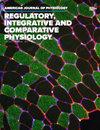Pioglitazone does not enhance exogenous glucose oxidation or metabolic clearance rate during aerobic exercise in men under acute high altitude exposure
IF 2.2
3区 医学
Q3 PHYSIOLOGY
American journal of physiology. Regulatory, integrative and comparative physiology
Pub Date : 2024-04-29
DOI:10.1152/ajpregu.00064.2024
引用次数: 0
Abstract
Insulin insensitivity decreases exogenous glucose oxidation and metabolic clearance rate (MCR) during aerobic exercise in unacclimatized lowlanders at high altitude (HA). Whether use of an oral insulin sensitizer prior to acute HA exposure enhances exogenous glucose oxidation is unclear. This study investigated the impact of Pioglitazone (PIO) on exogenous glucose oxidation and glucose turnover compared to placebo (PLA) during aerobic exercise at HA. Using a randomized, crossover design, native lowlanders (n=7 males, mean±SD, age: 23±6 yr, body mass: 84±11 kg) consumed 145 g (1.8 g/min) glucose while performing 80-min of steady-state (1.43±0.16 V̇O2 L/min) treadmill exercise at HA (460 mmHg) following short-term (5 days) use of PIO (15 mg oral dose per day) or PLA (microcrystalline cellulose pill). Substrate oxidation and glucose turnover were determined using indirect calorimetry and stable isotopes (13C-glucose and [6,6-2H2]-glucose). Exogenous glucose oxidation was not different between PIO (0.31±0.03 g/min) and PLA (0.32±0.09 g/min). Total carbohydrate oxidation (PIO: 1.65±0.22 g/min, PLA: 1.68±0.32 g/min) or fat oxidation (PIO: 0.10±0.0.08 g/min, PLA: 0.09±0.07 g/min) were not different between treatments. There was no treatment effect on glucose rate of appearance (PIO: 2.46±0.27, PLA: 2.43±0.27 mg/kg/min), disappearance (PIO: 2.19±0.17, PLA: 2.20 ± 0.22 mg/kg/min), or MCR (PIO: 1.63±0.37, PLA: 1.73±0.40 mL/kg/min). Results from this study indicate that PIO is not an effective intervention to enhance exogenous glucose oxidation or MCR during acute HA exposure. Lack of effect with PIO suggests the etiology of glucose metabolism dysregulation during acute HA exposure may not result from insulin resistance in peripheral tissues.吡格列酮不会提高男性在急性高海拔地区进行有氧运动时的外源性葡萄糖氧化率或代谢清除率
胰岛素不敏感会降低未适应高海拔(HA)的低地人在有氧运动中的外源性葡萄糖氧化作用和代谢清除率(MCR)。在急性高海拔暴露之前口服胰岛素增敏剂是否会增强外源性葡萄糖氧化作用尚不清楚。本研究调查了在高海拔地区进行有氧运动时,与安慰剂(PLA)相比,吡格列酮对外源性葡萄糖氧化和葡萄糖周转的影响。采用随机、交叉设计,低地本地人(7 名男性,平均±SD,年龄:23±6 岁,体重:84±11 千克)在 HA(460 毫米汞柱)条件下进行 80 分钟稳态(1.43±0.16 V̇O2 L/min)跑步机运动时,在短期(5 天)服用 PIO(每天口服 15 毫克)或 PLA(微晶纤维素药片)后,消耗 145 克(1.8 克/分钟)葡萄糖。使用间接量热法和稳定同位素(13C-葡萄糖和[6,6-2H2]-葡萄糖)测定底物氧化和葡萄糖周转。PIO(0.31±0.03 g/min)和 PLA(0.32±0.09 g/min)的外源葡萄糖氧化量没有差异。总碳水化合物氧化(PIO:1.65±0.22 g/min,PLA:1.68±0.32 g/min)或脂肪氧化(PIO:0.10±0.0.08 g/min,PLA:0.09±0.07 g/min)在不同处理之间没有差异。对葡萄糖出现率(PIO:2.46±0.27,PLA:2.43±0.27 mg/kg/min)、消失率(PIO:2.19±0.17,PLA:2.20±0.22 mg/kg/min)或 MCR(PIO:1.63±0.37,PLA:1.73±0.40 mL/kg/min)没有影响。这项研究的结果表明,在急性 HA 暴露期间,PIO 并非增强外源性葡萄糖氧化或 MCR 的有效干预措施。PIO 缺乏效果表明,急性 HA 暴露期间葡萄糖代谢失调的病因可能不是外周组织的胰岛素抵抗。
本文章由计算机程序翻译,如有差异,请以英文原文为准。
求助全文
约1分钟内获得全文
求助全文
来源期刊
CiteScore
5.30
自引率
3.60%
发文量
145
审稿时长
2 months
期刊介绍:
The American Journal of Physiology-Regulatory, Integrative and Comparative Physiology publishes original investigations that illuminate normal or abnormal regulation and integration of physiological mechanisms at all levels of biological organization, ranging from molecules to humans, including clinical investigations. Major areas of emphasis include regulation in genetically modified animals; model organisms; development and tissue plasticity; neurohumoral control of circulation and hypertension; local control of circulation; cardiac and renal integration; thirst and volume, electrolyte homeostasis; glucose homeostasis and energy balance; appetite and obesity; inflammation and cytokines; integrative physiology of pregnancy-parturition-lactation; and thermoregulation and adaptations to exercise and environmental stress.

 求助内容:
求助内容: 应助结果提醒方式:
应助结果提醒方式:


